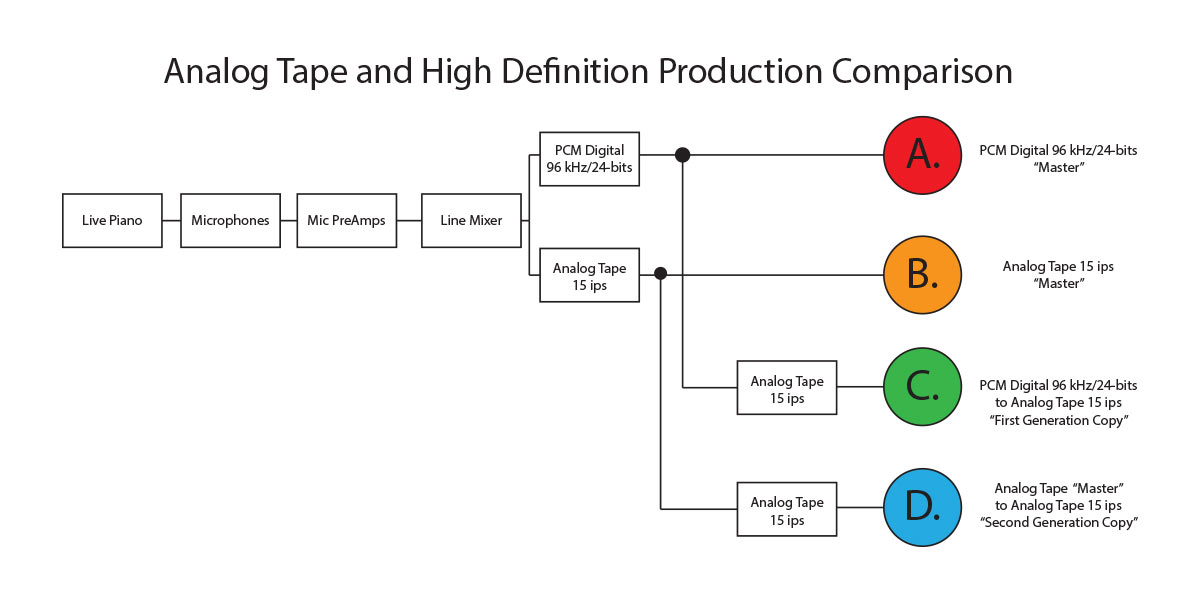An Analog Tape vs. PCM Comparison
I know I’ve been dwelling on the session that I just finished but I feel justified because it was a very unusual production. All morning I’ve been slicing analog tape, inserting leader tape and using my razor blades skills after a very long hiatus from this sort of work. It actually feels good to know that I still can manage my way around the older tools. I’ve done thousands of analog edits during my career and realize that it’s a lost art…at least with regards to the next generation of audio engineers.
I’ve actually thought about teaching analog editing to my engineering students but the fact is the studio doesn’t have a functioning reel-to-reel machine. It would undoubtedly be valuable just as the manual film editing that my youngest son did at NYU film school, but they would probably complain on the basis of it being irrelevant. And who knows what they would do with a single edge razor blade.
My other flashback has been happening across the hall on the tech bench. I needed to solder some input and output cables together in order to use my Nagra (this is proving more difficult as I can’t see quite as well as I used to…at least close up…I’ve resisted reading glasses thus far). I managed to get the input cable built prior to the session but am having difficulties getting the output cable to interface with my patch bay. Something is amiss, so my hope to have a re-digitized version of the analog tape at 96 kHz/24-bits will have to wait. But I have made progress.
I drove to the valley yesterday morning to return the SD 788T machine. When I was explaining my idea for comparing analog and digital to analog tape transfers to Val (a longtime friend, former student and member of the team at LSC) at Location Sound Corporation (a great place in LA to rent location sound equipment). I realized that I hadn’t done the SD 788T to Nagra transfers that I had planned. So with his generosity I took the machine back to the studio and spent part of yesterday and this morning transferring a few pieces from the digital recorder to the Nagra at exactly the same level. I’ll deliver the machine back today.
The analog reel-to-reel community is adamant that analog tape is the “ultimate recording format”. Dr. David Robinson has said that a 15 ips analog tape captures the sound of music making better than any digital format AND that a DSD copy of that tape is near perfection (I’m paraphrasing but you get the idea). Audiophiles are spending large sums of money on equipment (think United Home Audio) and tape copies (The Tape Project). I’ve been in touch with a reel-to-reel group and heard from David Pogue (a member and analog tape guy) that he’s only interested in tape copies that have been made from analog originals. A digital recording at 96 kHz/24-bits to analog tape is not interesting because of the digital stage in the production chain. He actually told me that he had tried this very thing and the resulted still sounded “digital” (whatever that means!).
So here’s my plan. Since I have a recording that was done simultaneously to high definition PCM digital at 96 kHz/24-bits AND to one of the best analog 2.0-channel tape machines ever made, I think it would interesting to give readers of this site AND the members of the reel to reel group a chance to hear these recordings in all possible formats. I will post a few minutes of a selection or two on the FTP site for all to download. There will be the 96 kHz/24-bit PCM stereo digital master, a re-digitized copy of the analog tape at 96 kHz/24-bits AND a re-digitized copy of an analog copy done directly from the SD 788T to analog tape. I’ll also make a tape to tape copy. See the diagram below:
Figure 1 – The production options that will be available soon. Click to enlarge.
So there are four options. I’ll be interested to see what you think. Give me a little more time to get the production stuff sorted out. Lest the analog reel to reel folks think that the conversion from analog back to digital is short circuiting the results, I will be preparing an analog tape that I will send to anyone that has the right equipment to audition it and is willing to send it on to others (or back to me)…I’m only going to make one of these reel to reel tapes at 15 ips. It will contain the master recording, the transfer from digital to analog and a second-generation copy (and maybe a third generation copy, which more closely represents what analog audiophiles get from The Tape Company and others).
This should be interesting. It unfortunately that I don’t have a larger ensemble to run through this process but a solo piano should be sonically rich enough to make a fair comparison.
My hope is the reel-to-reel community will not hear any “digital” degradation on the analog copy and then be willing to purchase HD-Audio digital copies to analog tape. We’ll see.



I agree with Grant’s comment from yesterday, a blind study would be interesting. If there are enough listeners, you can even collect some statistics.